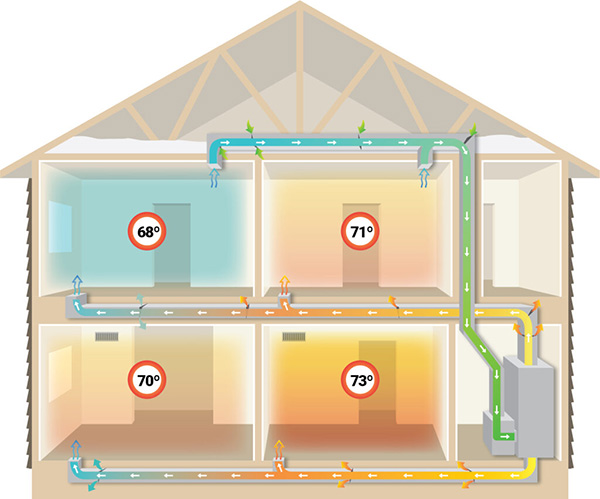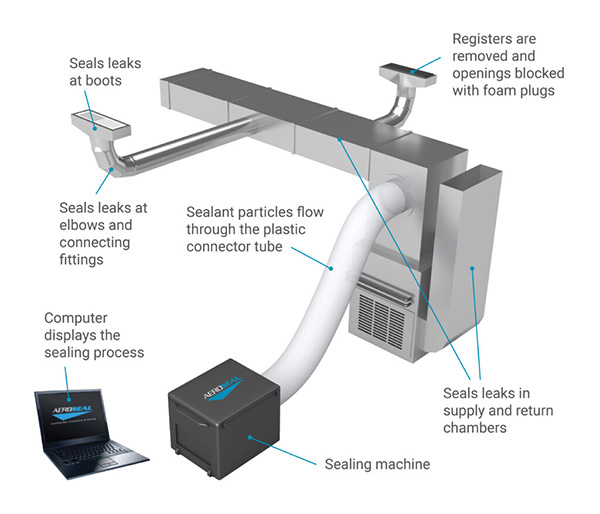Ductwork 101: How It Works and Why You Should Care

Why Ductwork?
Why is there ductwork at all? Why can’t you just set that HVAC unit in the middle of the home and turn it on? Those that are closest to it will enjoy that conditioned air. And those that are furthest away? They won’t. If we’re not delivering and retrieving air from various spaces, we’re essentially just huddling around a fire like we did thousands of years ago. We’ve come a long way, and we’ve learned why quality ductwork matters.
What Is Ductwork?
Ductwork serves as the conduit through which both conditioned and unconditioned air is circulated within residential and commercial buildings. This intricate network of passages, crafted from materials like sheet metal or flex duct, facilitates the movement of air to every corner of a structure, ensuring optimal comfort and indoor air quality.
What Ductwork is For
Ductwork acts as the circulatory system of an HVAC setup, facilitating the movement of air throughout living and commercial spaces. Just as veins and arteries distribute blood throughout the human body, ductwork distributes both unconditioned and conditioned air to ensure consistent airflow to every room.
The heart of a forced air HVAC system lies in a robust blower, situated within the air handler unit. Whether powered by a gas, electric, or oil furnace, this powerful fan propels air throughout the ductwork, circulating tons of air daily. When activated, the blower creates negative pressure, drawing air into the system where it undergoes conditioning. Subsequently, the conditioned air is then distributed via the ductwork to effectively heat or cool the various living spaces within a building. Ductwork is crucial for maintaining comfort, indoor air quality, and energy efficiency.
The Multifaceted Role of Ductwork within Buildings
Within the architectural confines of a building, ductwork assumes myriad roles that are pivotal in maintaining optimal comfort and indoor air quality. Beyond the mere conveyance of conditioned air to various living spaces, ductwork also plays a crucial role in facilitating the return of air to the HVAC system for reconditioning—a process essential for sustaining a healthy and balanced indoor environment. To be comfortable, most people prefer a temperature of around 70 degrees, and a relative humidity between 40% and 50%. By regulating temperature, humidity levels, and air quality, ductwork becomes the silent sentinel safeguarding the well-being of occupants, ensuring their comfort and productivity remain uncompromised.

Leaky Ductwork
When homeowners are facing issues such as inconsistent room temperatures and discomfort, many of them will just go out and buy a robust and expensive HVAC unit. Well, that piece of pricey equipment isn’t strictly an HVAC system any more than a car is strictly an engine. Even if someone takes the fastest engine out there and then connects it to a transmission that’s leaking fluid and grinding through first and second gear, that car isn’t going to win any drag races.
Your ductwork is an equally important part of your HVAC system as your blower, and it’s crucial that it’s performing properly. This means attacking the problem of duct leakage. All buildings and ducts leak air. Even new ductwork. How much leakage will vary uniquely from building to building.
Over the past three decades, our understanding of duct leakage has revealed its significant impact on energy consumption and HVAC system carbon footprints. Leakage, whether on the return or supply side, requires systems to work harder and use more energy to maintain indoor conditions.
n winter, imagine carrying a bucket of hot water from a central location to the furthest room in a building. If the bucket has holes, by the time you reach the destination, much of the hot water has leaked out, leaving it lukewarm. Similarly with duct leakage, unconditioned air infiltrates the system, reducing efficiency and compromising indoor comfort. To ensure optimal performance, every cubic foot of air should be efficiently circulated through the system, undergoing conditioning as needed, and evenly distributed throughout the living spaces. If your basement is always too cold, and your bedroom is always too hot, you’re likely experiencing the impact of leaky ductwork.
How Aeroseal Sees Ductwork Differently
So why is the issue of duct leakage so underreported and overlooked? Well, it’s an invisible assailant. Also, it’s an incredibly laborious process to fix it.
You would need to manually seal each metal connection and gap with tape or sticky duct sealant. What about ductwork that’s inaccessible? You would have to rip out the drywall. Who wants that?
So, what if there was a way to seal all the ductwork, even the unexposed, from a single injection point? That’s where Aeroseal comes in. Aeroseal is the only machine air sealing company that can seal leaks and take air leakage down to nearly zero in one simple process. Even the leaks you can’t see.
Aeroseal’s mission is to revolutionize the way buildings consume energy, drastically reducing their carbon emissions in a simple, safe, and cost-effective way. Employing groundbreaking automated technology, Aeroseal’s non-toxic, water-based sealant efficiently seals air leaks in both ducts and the building envelope itself, ensuring that your air goes where you need it and not where you don’t.














